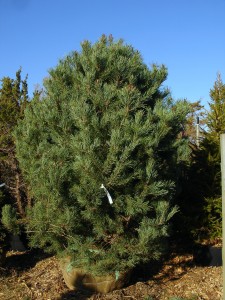
As deciduous trees and shrubs begin to drop their leaves, evergreens become more and more visible around the island. There are many species of evergreen trees that grow well on Nantucket. Pine trees are one of the most widespread.
Eastern White Pine, Pinus strobus, Scot’s Pine, Pinus sylvestris, Pitch Pine, Pinus rigida, and Jack Pine, Pinus banksiana can all be found growing in different areas of Nantucket. The majority of pine trees seen in our forested areas are Pitch Pine. This is a medium-sized tree that is native to eastern North America. Pitch Pines have shortish needles, in bundles of three, that are often slightly twisted. Although Pinus rigida is a sturdy tree with good salt tolerance, there are many better pines for landscape use. For this reason, it is not readily available in the trade.
We sell a variety of Pines at the nursery, however the following species are the most commonly planted today:
•Austrian Pine, Pinus nigra, is much more available and often used for screening and windbreaks. They are densely pyramidal in youth, and broad, flat-topped when mature. They can reach 30-50 feet tall, inland, but will tend to remain on the shorter side close to the shore. They are often the tallest trees in a given area, due to their salt and wind tolerance. They do well in average soil as long as it is well drained and prefer not to be on automatic irrigation, once established.
•Japanese Black Pine, Pinus thunbergii, is another common pine tree that we sell at the nursery. Like Austrian pine, they are tolerant of salt spray and wind and can survive coastal conditions. These trees have been widely planted on the island for years, and have become naturalized in some areas. Because this tree is not native to North America and produces viable seed, some consider it to be problematic, and it is being removed in several areas. Pinus thunbergii ‘Thunderhead’ is a highly ornamental cultivar that is worth a try. This tree is irregularly pyramidal, with long white buds that contrast well with its dark grey-green needles. More compact than the species, ‘Thunderhead’ reaches 10 to 15 feet tall in ten years with a dense habit.
•Bosnian Pine, Pinus heldreichii aka leucodermis, is of increasing popularity. It may be a good alternative for gardeners that prefer not to plant Japanese Black Pine. Trees in the nursery are arguably more ornamental than Japanese Black Pine, and denser in habit. They are touted to have comparable salt and wind tolerance of Pinus nigra and thunbergii and are suitable for planting in dry soils. Several landscapers on the island have found Bosnian pine to be less likely to suffer infestation by black turpentine beetles than others.
